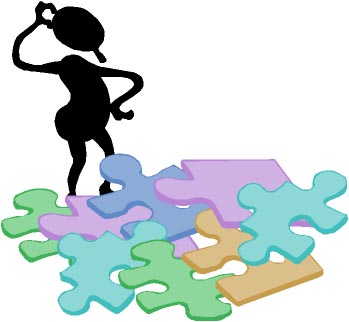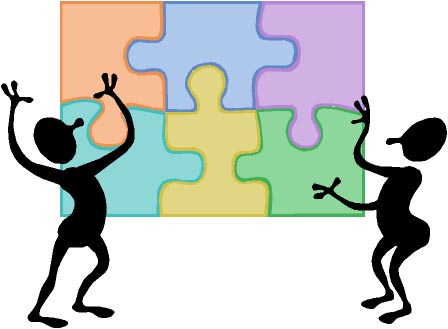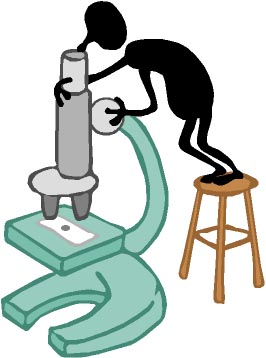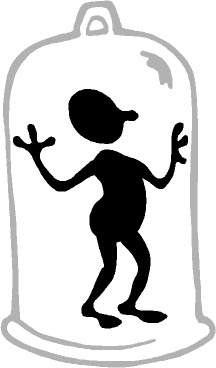DOING THAT?
 (The
devil made me do it.)
(The
devil made me do it.) (The
devil made me do it.)
(The
devil made me do it.)
 Part of resolving a problem situation is making sense of it.
Part of resolving a problem situation is making sense of it. 
This page presents four views on how to figure out why a youngster
is misbehaving. The first model represents the views of Rudolph
Dreikurs. The second represents the views of behaviorists who advocate
for the process and procedures of applied behavior analysis. The
third involves discussion with the student. The fourth is a procedure
known as "Functional Behavior Assessment".
VIEW #1 DREIKURS
According to Rudolph Dreikurs, kids misbehave
and seek "mistaken goals" when they do not
have a sense of belonging or being valued. There are ways to determine
the function of/reason for a youngster's behavior. The system below
applies primarily to pre-adolescents. Adolescents will often have
other reasons for misbehaving (e.g., group influence, rebellion against
authority, etc.) in addition to the ones listed below. We should
also keep in mind that some youngsters have not learned how to behave in
the ways expected in schools. Many low income, immigrant, and/or
culturally different youngsters may have learned other "right ways" to
behave in certain situations. They may need to be taught the behaviors
that you expect in your classroom (or you might have to change your
ways to be more accepting of diversity and differences).
According to Dreikurs, kids can act up for a number of reasons. Here's a little background before we offer solutions.
![]() ATTENTION
SEEKING
ATTENTION
SEEKING.gif)
Pesky, attention seeking behavior results when
kids aren't getting the recognition they feel they deserve. If they
can't get attention for their positive behaviors (e.g., being on-task,
completing work, arriving on time, being nice to others), they'll seek
it with inappropriate behaviors. They feel important if the teacher
pays attention to them and provides them with extra services. They
may:
-continually call out
-refuse to work unless a teacher hovers over them
-ask irrelevant questions
So be sure to "catch 'em being good".
SEEKING POWER![]()
If attention seeking doesn't work, youngsters,
out of spite, may try to make your professional life miserable. They
may:
-argue
-contradict
-lie
-refuse to work or follow directions
-throw a temper tantrum
-tell you to "go take a flying leap"
-behave hostilely toward you
 SEEKING
REVENGE
SEEKING
REVENGE
If attention or power seeking doesn't work, kids
may seek revenge against you or others. Their belief is that: "I
can only feel significant if I hurt others. I'm just doing what they've
done to me. I don't care if I'm disliked. They deserve this
behavior. It is a victory to be disliked and to undergo punishment."
These kids may:
-treat others cruelly
-set themselves up to be punished
-engage in pranks or vandalism behind your back
DISPLAYING INADEQUACY ![]()
Underneath the bravado of seeking revenge is
deep discouragement. The rejection by others eventually makes them
feel worthless. They think: "Why even try anymore?"
They guard what is left of their self esteem by removing themselves from
public and social tests. They think: "If I pretend
to be stupid or refuse to cooperate, people will leave me alone."
They may:
-passively refuse to participate in class activities
-sit silently and engage in no interaction
-request to be left alone
![]() SO
WHAT DO WE DO
SO
WHAT DO WE DO![]()
1. Do things and conduct activities in a manner that will help
the youngsters to develop a sense of belonging and esprit de corp, and
a feeling of being valued by others in your classroom/school.
Focus on developing a supportive team spirit in your classroom.
2. ![]() Identify
the "mistaken goal" by analyzing the
situation in the following ways:
Identify
the "mistaken goal" by analyzing the
situation in the following ways:
If you are:
The student is probably seeking:
![]() Annoyed
Attention
Annoyed
Attention![]()
Threatened![]() Power
Power![]()
Hurt Revenge
Powerless
Inadequacy
If students: Then their probable goal is:
Stop a behavior, but then repeat it.
Attention
Refuse to stop and increase the misbehavior.
Power
Become violent or hostile.
Revenge
Refuse to cooperate, participate, or interact
Inadequacy
3. Address the mistaken goal in a friendly, respectful, non threatening manner. This course of action removes the power of the mistaken goal. Try this approach using concerned, polite, non sarcastic wording and tone.
-"Could it be that you'd like me to spend more time with you?"
(attention)
-"When you try to prove that nobody can make you do things
if you don't want to
do ‘em, is it possible
that you're showing that you're upset with us?" (power)
-"When you did that, were you trying to hurt me because you're
angry with
me? (revenge)
-"When you pretend that you're not capable of doing this work,
are you trying to
make me go away?" (displaying
inadequacy)
4. Explain that experts know about this behavior, have studied it for generations and know of better ways for youngsters to get their needs met. Discuss the faulty logic involved in the youngster's thinking/actions, and help him/her devise a plan to meet his/her needs in appropriate ways.
5. Change your actions when confronted by the various behaviors:
ATTENTION
-Provide the youngster with acceptable ways of gaining the attention
that is sought.
Role play those new ways to increase the
chances of them being used. Give
signals/hints to prompt the behavior in the real
life situations.
-Set up a plan with the youngster which allows him/her to earn time
with you.
-Provide the youngster with supports (e.g., a peer who will
help the youngster if
academic difficulties occur)
-Remind the youngster of what must be done to get your attention
(e.g., raise
hand). If this is not yet a usual behavior
for the youngster, give your attention
immediately to reinforce that correct behavior.
Verbally praise the youngster
for displaying the appropriate behavior.
Wean the student from the immediate
reaction on your part by telling him/her that
you see his/her appropriate behavior
and that you'll be there in just a minute (after
attending to the other hand raisers
first, or finishing the writing of a note, etc.)
POWER
-Avoid power struggles. Stay out of the "Conflict
Cycle". Prevent escalation of
the event. Seek solutions, not blame.
-Acknowledge the youngster's need for power.
-Involve the student in making decisions.
-Give responsibilities and positions of influence to the youngster.
- Use an "I message" followed by a
question:
-"I'm hearing some offensive language. Would you be kind enough to
restate your opinion in more polite terms?"
(Click
here for more information and practice on "I messages")
REVENGE
SEEKING![]()
-Design activities in which the student and others come to view
each other
positively.
-Bond with the youngster. Give him/her the time of day.
Build a friendly
relationship.
-Expect resistance to your efforts at first. Persistence is
required.
DISPLAYING INADEQUACY
-Offer encouragement and support.
-Blame the lack of success on the curriculum, materials, or the
way you taught the
lesson, but do notblame
the youngster.
-Set the youngster up for success and recognize his/her efforts.
-Have the student self evaluate what s/he did right and wrong and
develop a plan
for improvement (or have him/her redo the task
well). Assist as needed.
-NEVER show your frustration
as this reaction may reinforce the sense of
worthlessness.
VIEW #2 THE BEHAVIORISTS' A-B-C MODEL
Those who advocate for "applied behavior analysis" would offer the following advice when trying to determine why a youngster demonstrates certain behaviors: Identify the behavior of concern, defining and describing it. Next, try to determine what event(s) happened right before that behavior. Finally, note what happens as a result of the youngster's behavior. With this information, you should be able to make a good guess at what brings about and maintains the youngster's behavior. This information can also be used to modify or eliminate the behavior.
The behaviorist paradigm for determining the "why" of a behavior is identified by the symbols A, B, and C, representing "Antecedent" (the stimulus that caused or "sparked" the behavior), "Behavior" (the student's action that followed the antecedent), and "Consequence" (the reward that followed the behavior). Behaviorists believe that people show behaviors because they get some sort of reward for doing so (e.g., attention, power, recognition, money, release from assigned duties, physical pleasure, etc.). In their minds, behaviors (your's, mine, and the kids') continue and become ingrained because those actions bring something desirable to us, or remove something undesirable from our midst.
When dealing with student misbehavior, the trick
is to figure out what is maintaining the behavior and then manipulate the environment so that behavior no longer receives
that reward.
and then manipulate the environment so that behavior no longer receives
that reward.
If the behavior receives no reward, it will cease (after an initial escalation of the behavior in continued and intensified attempt to obtain a reward in the way that has worked previously).
Another approach is to require a new behavior in order for the student to get the desired reward. We ask the student to demonstrate a replacement behavior if he or she wishes to obtain the desired reinforcement.
A third approach is to manipulate the situation so that the antecedent never occurs. The behavior won't happen if there is no stimulus for it to occur.
You see that you can change the A, B, or C (or combinations of them).
Example
The teacher asks a question
to the class (Antecedent). Raheem yells out an answer (Behavior).
Teacher tells Raheem to raise his hand next time (as s/he always tells
him to do), but accepts the answer and goes on with the lesson (Consequence
- Raheem got to show how smart he was, beat out his competition...other
kids, and even got a bit of personal interaction from the teacher during
the lesson).
In this situation, the teacher could eliminate the antecedent by calling on particular students (after the question is said, not before...or all the other students will let their minds wander). The teacher might also change the consequence by ignoring the answer ("I only hear the answer of students who raise their hands and wait to be called upon. I'm looking for a hand.") or penalizing "calling out" behavior (while praising the hand raising of other students). The teacher might also work with Raheem to develop a new behavior to get the reward/reinforcement. Each time Raheem raises his hand (whether he knows the answer or not, and whether he is called upon by the teacher or not) he gets a point. Twenty points allows him to present information to the class tomorrow, or gives him five minutes of personal time with the teacher (allowing him to receive the desired rewards of appearing knowledgeable or gaining personal contact with the teacher).
VIEW #3 Dr. Mac's Compassionate Questioning
Why don't we just ask the kid? Easier said than done. Remember back to when you have been questioned about personal issues by those you didn't know, didn't like, or didn't trust. Were you be totally honest? Did you avoid saying some things? Did you mislead them?
Certain conditions must
be present if you are to gain useful information from youngsters:
1. The student
has to like you, value your input, and trust that you will use the information
in a caring way.
2. You must ask
in a way that evidences concern, caring, and respect. This is not
an inquisition. Really listen...don't give into an urge to lecture
or badger. Avoid making judgements.
Certain practices will help
the youngster to share his/her thoughts, view, and insights:
1. Active and
non-directive listening (see the "non-directive
counseling" link on the home page).
2. A systematic
approach (see the "classroom
counseling" link on the home page).
VIEW #4 Functional Behavior
Assessment
| CLICK HERE for the link that explains how to conduct a functional behavior assessment. |
![]()
Pooch, I see you running alot. Can you tell me why that is?
| Fetch Dr. Mac's Home Page |